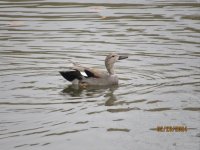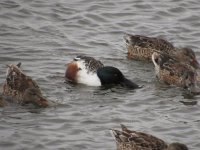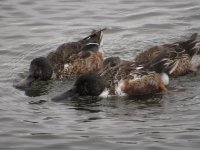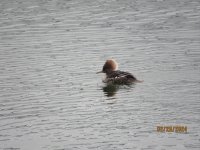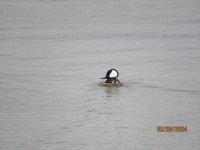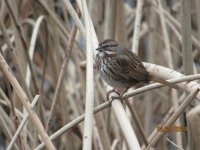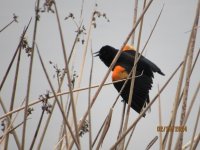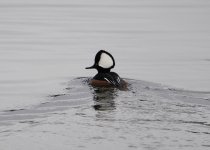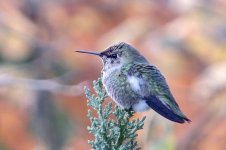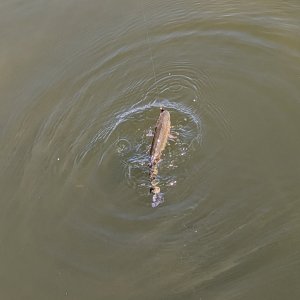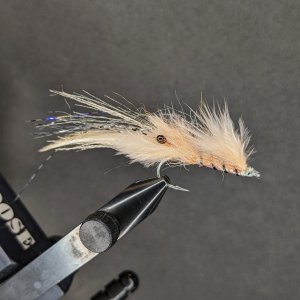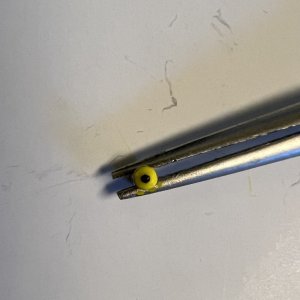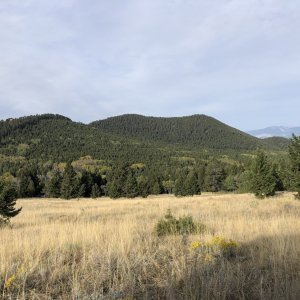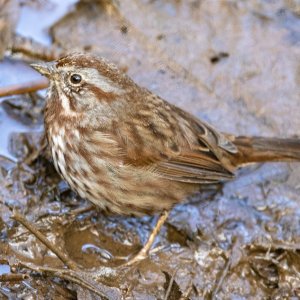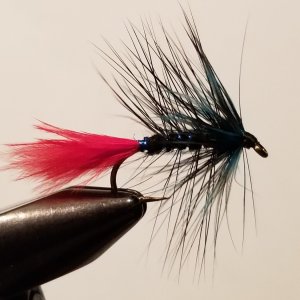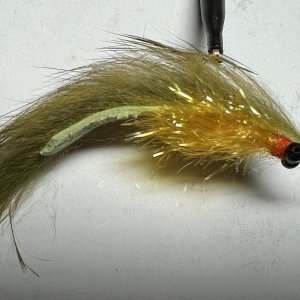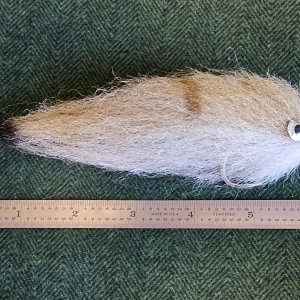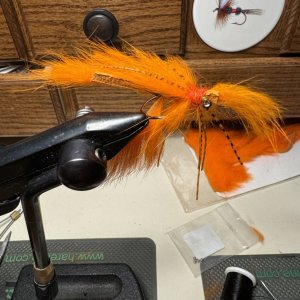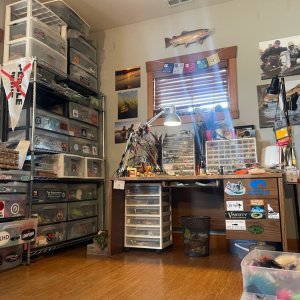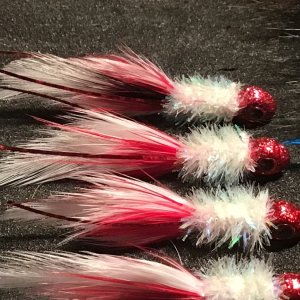Navigation
Install the app
How to install the app on iOS
Follow along with the video below to see how to install our site as a web app on your home screen.
Note: This feature may not be available in some browsers.
More options
Style variation
You are using an out of date browser. It may not display this or other websites correctly.
You should upgrade or use an alternative browser.
You should upgrade or use an alternative browser.
Got any bird pics?
- Thread starter Wadin' Boot
- Start date
I have seen them gathering spider webs for the nest lining.
Waterfowl hunting season is now finished for the year. This has removed one source of risk for the overwintering ducks, geese, and shorebirds at Nisqually Wildlife Refuge. And with spring breeding season fast approaching, some birds are beginning to pair up. They are feeding like crazy to build up reserves to fuel their migration and the upcoming reproductive season.
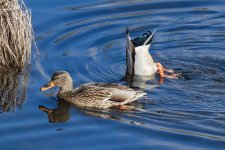
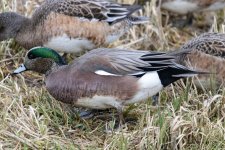
Diving ducks, like ring-necked ducks and buffleheads have been diving repeatedly in the central pond near the Visitor Center. In the right light, the heads of the drake buffleheads shine with a green-purple iridescence.
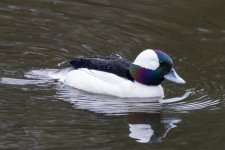
The feathers of the hens are not iridescent.
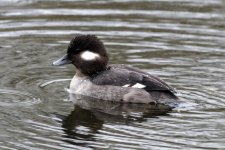
The drake’s coloration is NOT due to the selective absorption / reflection of a pigment, but due to structural iridescence in its feathers. The red pigments in the head feathers of a male house finch or the breast of male robin reflect red wavelengths of light and absorb all others. But birds with iridescent coloration (e.g., head feathers of hummingbird males, birds of paradise, and buffleheads, tail feathers of peacock males), layers of intracellular sacks of melanin (melanosomes) refract (bend) light physically as the photons travel through layers of these sacks. If the light is not from the right direction, the feathers absorb all wavelengths (e.g., black), but from other directions, they glow.
A recent addition to the divers in the main pond has been a pied-billed grebe in breeding plumage (dark ring on the bill).
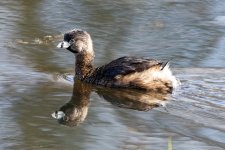
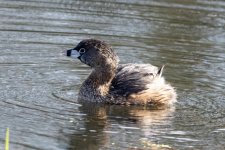
In my last visit, it came up from a dive with a fish in its bill (possibly a sculpin) which it easily swallowed.
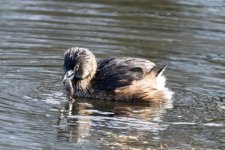
Another birder pointed out a Wilson's snipe that was feeding at the edge of a freshwater seep into the main pond by the Visitor Center. Wilson's snipes are so cryptic, it would take an especially perceptive predator to find them foraging along the shoreline. And if it were found, they have an amazing burst flight to escape.
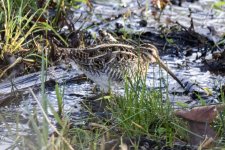
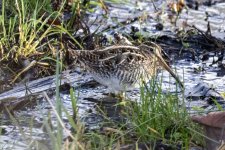
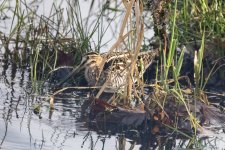
Steve


Diving ducks, like ring-necked ducks and buffleheads have been diving repeatedly in the central pond near the Visitor Center. In the right light, the heads of the drake buffleheads shine with a green-purple iridescence.

The feathers of the hens are not iridescent.

The drake’s coloration is NOT due to the selective absorption / reflection of a pigment, but due to structural iridescence in its feathers. The red pigments in the head feathers of a male house finch or the breast of male robin reflect red wavelengths of light and absorb all others. But birds with iridescent coloration (e.g., head feathers of hummingbird males, birds of paradise, and buffleheads, tail feathers of peacock males), layers of intracellular sacks of melanin (melanosomes) refract (bend) light physically as the photons travel through layers of these sacks. If the light is not from the right direction, the feathers absorb all wavelengths (e.g., black), but from other directions, they glow.
A recent addition to the divers in the main pond has been a pied-billed grebe in breeding plumage (dark ring on the bill).


In my last visit, it came up from a dive with a fish in its bill (possibly a sculpin) which it easily swallowed.

Another birder pointed out a Wilson's snipe that was feeding at the edge of a freshwater seep into the main pond by the Visitor Center. Wilson's snipes are so cryptic, it would take an especially perceptive predator to find them foraging along the shoreline. And if it were found, they have an amazing burst flight to escape.



Steve
Me too, and a few days ago I watched a male Anna’s hummingbird do its mating display flight in a clearing in Lincoln Park, over and over.I have seen them gathering spider webs for the nest lining.
Had a drake at our local pond last week. One of my many favorites and I have a lot of favorites
Thanks for your excellent explanation of feather iridenscence. It adds depth to my appreciation of the wonders of nature.Waterfowl hunting season is now finished for the year. This has removed one source of risk for the overwintering ducks, geese, and shorebirds at Nisqually Wildlife Refuge. And with spring breeding season fast approaching, some birds are beginning to pair up. They are feeding like crazy to build up reserves to fuel their migration and the upcoming reproductive season.
View attachment 105191
View attachment 105192
Diving ducks, like ring-necked ducks and buffleheads have been diving repeatedly in the central pond near the Visitor Center. In the right light, the heads of the drake buffleheads shine with a green-purple iridescence.
View attachment 105193
The feathers of the hens are not iridescent.
View attachment 105194
The drake’s coloration is NOT due to the selective absorption / reflection of a pigment, but due to structural iridescence in its feathers. The red pigments in the head feathers of a male house finch or the breast of male robin reflect red wavelengths of light and absorb all others. But birds with iridescent coloration (e.g., head feathers of hummingbird males, birds of paradise, and buffleheads, tail feathers of peacock males), layers of intracellular sacks of melanin (melanosomes) refract (bend) light physically as the photons travel through layers of these sacks. If the light is not from the right direction, the feathers absorb all wavelengths (e.g., black), but from other directions, they glow.
A recent addition to the divers in the main pond has been a pied-billed grebe in breeding plumage (dark ring on the bill).
View attachment 105195
View attachment 105196
In my last visit, it came up from a dive with a fish in its bill (possibly a sculpin) which it easily swallowed.
View attachment 105197
Another birder pointed out a Wilson's snipe that was feeding at the edge of a freshwater seep into the main pond by the Visitor Center. Wilson's snipes are so cryptic, it would take an especially perceptive predator to find them foraging along the shoreline. And if it were found, they have an amazing burst flight to escape.
View attachment 105198
View attachment 105199
View attachment 105200
Steve
I've seen many buffleheads, but have yet to notice their head feather iridescence in the detail shown in your shot.
Ignore the snow showers that have fallen in the last few days and that are in the forecast for the next week. Spring is coming. How do I know? A Bewick’s wren told me. Explain yourself. O.K. All winter long the wrens have been playing hide-and-seek games in the undergrowth. You might see movement in the understory, but when you swing your binocs to the spot, nothing is there. And then you hear a warning scold from deep in a dense shrub. You know that the bird is there, but it isn’t going to put in an appearance. Then, you’ll see a flash as it flits off to another location to mock you more. Very frustrating.
But, at the end of my last visit to Nisqually Wildlife Refuge, I encountered a male Bewick’s wren who was boldly singing in the open. It moved from perch to perch within 30’ radius proclaiming his availability for the upcoming breeding season and warning off any potential rivals. This was his territory and he was going to celebrate it.
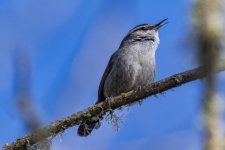
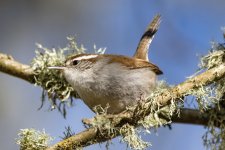
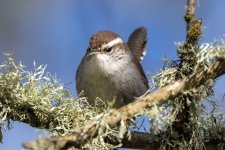
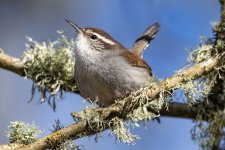
Just before this Bewick’s wren put on a show, I managed a nice view of the Bewick’s wren smaller cousin, the marsh wren. They have such a distinctive “shawl” across their shoulders. Like Bewick’s wrens, marsh wrens are notorious for calling from deep cover in the marsh or providing on brief glimpses as they flit from one clump of marsh grass to another.
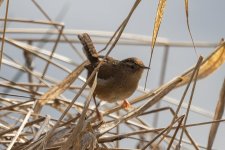
In contrast, song sparrows are NOT shy and they really don’t need a reason to sing. Frankly, they are camera hogs. But they have been more vocal lately and I expect that trend to continue
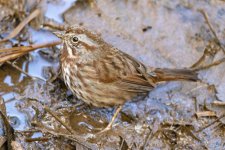
As I walk the boardwalks, I keep my ear tuned for chirping around me. I have always been impressed (and envious) when Amy and I have been out with professional bird guides with just how good their ears are to identifying different bird songs. I don’t have a very good ear, in my opinion, but I do recognize the local species (and we don’t have that much diversity compared to the Central America / Australia or even Southern Arizona). The free Merlin app has the ability to record sounds in the field and to compare the sounds to prior recordings that it has in its memory. It then lists the birds that it is hearing and highlights the name of the bird that is currently vocalizing. Not only is this great for alerting me to which species might just be present, but it also helps train my ear to associate specific sounds with specific species.
The Merlin app has some difficulty with some of the very generic “chip” sounds that some flocking birds make. There just are not enough differences in this “chips” among species to identify a specific species as responsible. That is the case often for mixed flocks such as chickadees and golden-crowned kinglets.
So even if the sounds are not diagnostic, they do pinpoint that there is a flock of insectivores gleaning insects in the trees. I can then try to position myself in front of their direction of movement and let the flock come to me. This tends to provide better photographic opportunities.
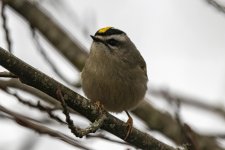
Listening is also helpful when trying to locate woodpeckers. Hairy and downy woodpeckers produce similar “peek” sounds. If I hear that sound, I start scanning the nearby tree trunks for these species.
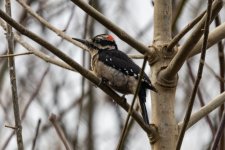
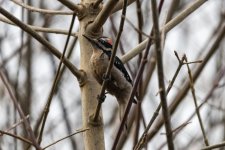
Red-breasted sapsuckers produce a “weep” sound. Again, if I head the sound, I try to find the bird. In this image, you can see that the stiff central shaft of the tail feathers are providing support for the bird, creating a solid base when the bird is hammering into a tree.
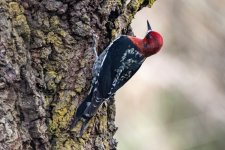
Steve
But, at the end of my last visit to Nisqually Wildlife Refuge, I encountered a male Bewick’s wren who was boldly singing in the open. It moved from perch to perch within 30’ radius proclaiming his availability for the upcoming breeding season and warning off any potential rivals. This was his territory and he was going to celebrate it.




Just before this Bewick’s wren put on a show, I managed a nice view of the Bewick’s wren smaller cousin, the marsh wren. They have such a distinctive “shawl” across their shoulders. Like Bewick’s wrens, marsh wrens are notorious for calling from deep cover in the marsh or providing on brief glimpses as they flit from one clump of marsh grass to another.

In contrast, song sparrows are NOT shy and they really don’t need a reason to sing. Frankly, they are camera hogs. But they have been more vocal lately and I expect that trend to continue

As I walk the boardwalks, I keep my ear tuned for chirping around me. I have always been impressed (and envious) when Amy and I have been out with professional bird guides with just how good their ears are to identifying different bird songs. I don’t have a very good ear, in my opinion, but I do recognize the local species (and we don’t have that much diversity compared to the Central America / Australia or even Southern Arizona). The free Merlin app has the ability to record sounds in the field and to compare the sounds to prior recordings that it has in its memory. It then lists the birds that it is hearing and highlights the name of the bird that is currently vocalizing. Not only is this great for alerting me to which species might just be present, but it also helps train my ear to associate specific sounds with specific species.
The Merlin app has some difficulty with some of the very generic “chip” sounds that some flocking birds make. There just are not enough differences in this “chips” among species to identify a specific species as responsible. That is the case often for mixed flocks such as chickadees and golden-crowned kinglets.
So even if the sounds are not diagnostic, they do pinpoint that there is a flock of insectivores gleaning insects in the trees. I can then try to position myself in front of their direction of movement and let the flock come to me. This tends to provide better photographic opportunities.

Listening is also helpful when trying to locate woodpeckers. Hairy and downy woodpeckers produce similar “peek” sounds. If I hear that sound, I start scanning the nearby tree trunks for these species.


Red-breasted sapsuckers produce a “weep” sound. Again, if I head the sound, I try to find the bird. In this image, you can see that the stiff central shaft of the tail feathers are providing support for the bird, creating a solid base when the bird is hammering into a tree.

Steve
Last edited:
Cabezon - I am humbled by your experience , input, knowledge and wonderful pics.
All I can say, is thank you.
All I can say, is thank you.
Bonefish Jack
Steelhead
I also respect and enjoy the knowledge you so willingly share. Thank you.The Merlin app has some difficulty with some of the very generic “chip” sounds that some flocking birds make. There just are not enough differences in this “chips” among species to identify a specific species as responsible. That is the case often for mixed flocks such as chickadees and golden-crowned kinglets.
I think Merlin is a great scouting and learning tool. Recently, Merlin has “heard” both White-breasted Nuthatches and White-throated Sparrows in my backyard. These would both be unusual birds for this location. I still haven’t seen either of them. The WTS are likely mixed in with the flock of Golden-crowned Sparrows that are always around.
Gyrfalcon22
Legend
Wanted to explain this one some. I have an eagle perch that is in the middle of nowhere. It sits about 1/2 mile from any access-which is a great thing for the birds. The local wintering golden eagle used this perch quite frequently and I always looked forward to seeing if he was there. This year he is very hit and miss.
Last edited:
While in Joseph, Oregon a few years ago for a June wedding, I did a little birding in the Wallowa Valley. I was hoping to see bobolinks and lucked upon this upland sandpiper. I heard his courtship call and tracked him down when he landed on this fence post. I have commonly seen them in the Northern Great Plains while storm chasing in the spring. I didn't realize there was a small breeding population in NE Oregon.
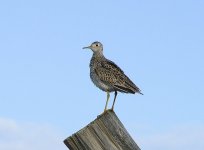

Last edited:
RRSmith - That is excellent.
joefromchicago
Steelhead
Wish I had a camera. Was just watching a huge gaggle of Canadian geese flying over my house (I live within a quarter-mile of a large shallow lake), looked like a scene from The Birds. Pretty spectacular.

